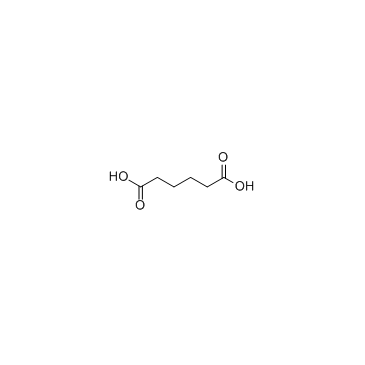Adipic acid

Adipic acid structure
|
Common Name | Adipic acid | ||
|---|---|---|---|---|
| CAS Number | 124-04-9 | Molecular Weight | 146.141 | |
| Density | 1.3±0.1 g/cm3 | Boiling Point | 338.5±15.0 °C at 760 mmHg | |
| Molecular Formula | C6H10O4 | Melting Point | 151-154 °C(lit.) | |
| MSDS | Chinese USA | Flash Point | 196 ºC | |
| Symbol |

GHS07 |
Signal Word | Warning | |
|
HMDB: a knowledgebase for the human metabolome.
Nucleic Acids Res. 37(Database issue) , D603-10, (2009) The Human Metabolome Database (HMDB, http://www.hmdb.ca) is a richly annotated resource that is designed to address the broad needs of biochemists, clinical chemists, physicians, medical geneticists, nutritionists and members of the metabolomics community. Si... |
|
|
Age-related reference values for urinary organic acids in a healthy Turkish pediatric population.
Clin. Chem. 40(6) , 862-6, (1994) Organic acid concentrations were quantified by gas chromatography and the individual acids identified by mass spectrometry in urine specimens from a healthy Turkish pediatric population of ages 2 days to 16 years, subdivided into five age groups. We quantifie... |
|
|
Prediction of skeletal muscle and fat mass in patients with advanced cancer using a metabolomic approach.
J. Nutr. 142(1) , 14-21, (2012) Urine and plasma metabolites originate from endogenous metabolic pathways in different organs and exogenous sources (diet). Urine and plasma were obtained from advanced cancer patients and investigated to determine if variations in lean and fat mass, dietary ... |
|
|
Coformer screening using thermal analysis based on binary phase diagrams.
Pharm. Res. 31(8) , 1946-57, (2014) The advent of cocrystals has demonstrated a growing need for efficient and comprehensive coformer screening in search of better development forms, including salt forms. Here, we investigated a coformer screening system for salts and cocrystals based on binary... |
|
|
Automated screening of urine samples for carbohydrates, organic and amino acids after treatment with urease.
J. Chromatogr. A. 562(1-2) , 125-38, (1991) Eighty-five clinical urine samples and nineteen urine samples previously found by other laboratories to suggest genetic metabolic defects were prepared for trimethylsilylation by treatment with urease, followed by azeotropic dehydration. The "Target Analyte S... |
|
|
Quantitative analysis for organic acids in biological samples: batch isolation followed by gas chromatographic-mass spectrometric analysis.
Clin. Chem. 35(4) , 587-95, (1989) This new method for qualitative and quantitative determination of organic acids, aldehydes, and ketones in biological samples is effective for use with urine, plasma, and amniotic fluid, and it requires no deproteinization. Isolation by batch-wise liquid part... |
|
|
Abnormal urinary excretion of unsaturated dicarboxylic acids in patients with medium-chain acyl-CoA dehydrogenase deficiency.
J. Lipid Res. 31(5) , 763-71, (1990) Medium-chain acyl-CoA dehydrogenase (MCAD) deficiency is the most frequently described metabolic disorder of fatty acid oxidation in humans. Acute episodes are usually characterized biochemically by the appearance of nonketotic dicarboxylic aciduria. In addit... |
|
|
Urinary and plasma organic acids and amino acids in chronic fatigue syndrome.
Clin. Chim. Acta 361(1-2) , 150-8, (2005) Previous work by others have suggested the occurrence of one or more chemical or metabolic 'markers' for ME/CFS including specific amino acids and organic acids and a number of unidentified compounds (CFSUM1, CFSUM2). We have shown elsewhere that CFSUM1 is pa... |
|
|
Structural variation governs substrate specificity for organic anion transporter (OAT) homologs. Potential remote sensing by OAT family members.
J. Biol. Chem. 282 , 23841-53, (2007) Organic anion transporters (OATs, SLC22) interact with a remarkably diverse array of endogenous and exogenous organic anions. However, little is known about the structural features that determine their substrate selectivity. We examined the substrate binding ... |
|
|
Synthesis and characterization of copolyanhydrides of carbohydrate-based galactaric acid and adipic acid.
Carbohydr. Res. 402 , 102-10, (2014) A series of copolyanhydrides, consisting of 2,3,4,5-tetra-O-acetylgalactaric acid (AGA) and adipic acid (AA) as monomer units, was polymerized. Synthesis of AGA monomer consisted of two steps. First, O-acetylation of galactaric acid secondary hydroxyl groups ... |